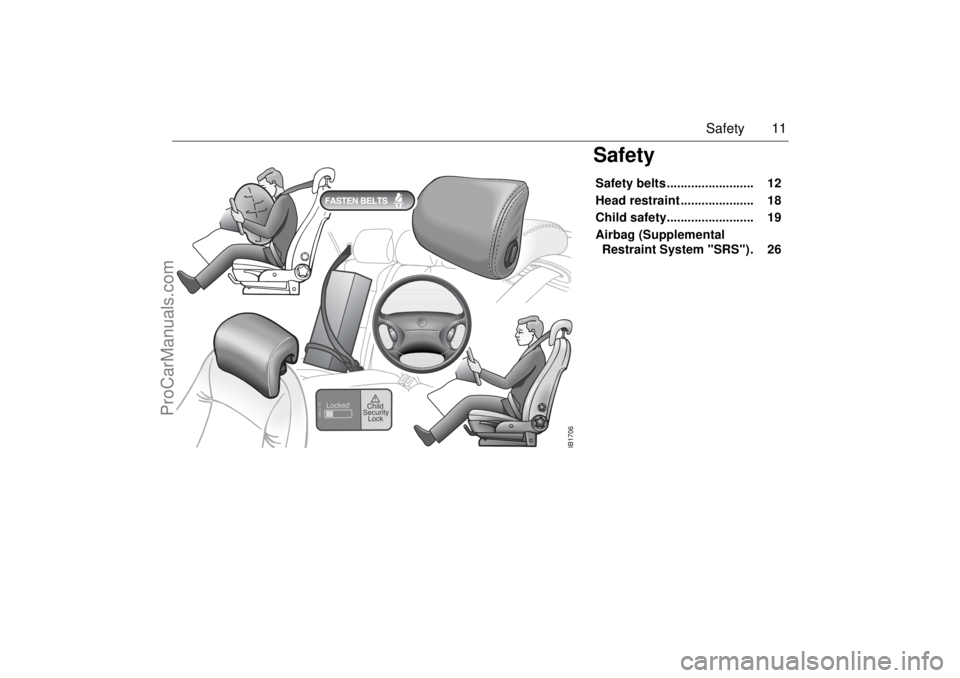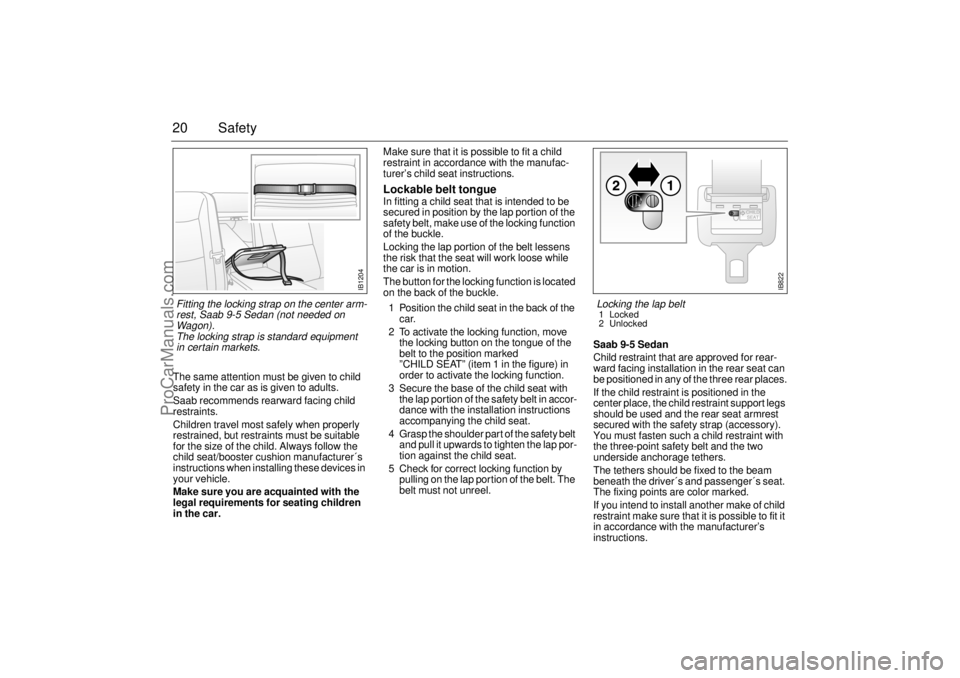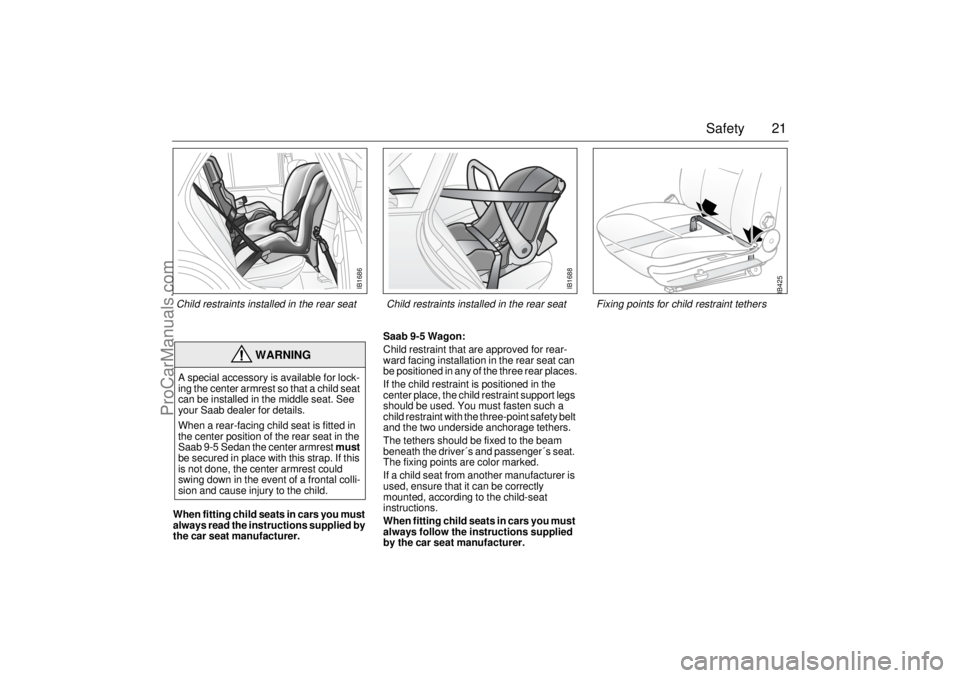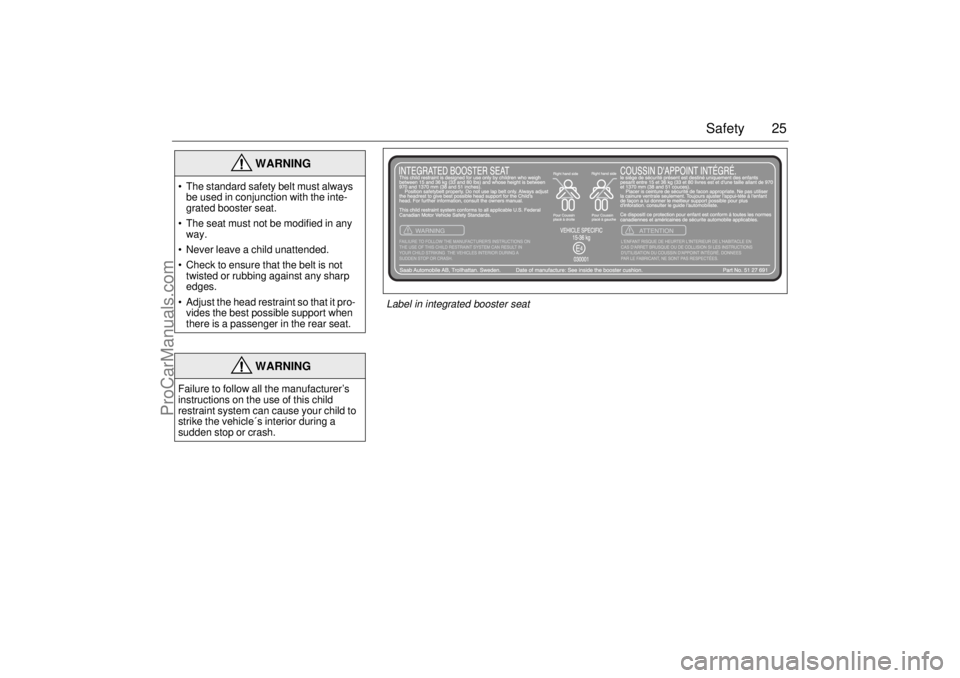2001 SAAB 9-5 child restraint
[x] Cancel search: child restraintPage 11 of 272

11 Safety
SafetySafety belts ......................... 12
Head restraint ..................... 18
Child safety......................... 19
Airbag (Supplemental
Restraint System "SRS"). 26
IB1706
ProCarManuals.com
Page 19 of 272

19 Safety
Child safety
Car safety tips Protect your children from getting
trapped in the trunk of a car
WARNING
Children must always be suitably
restrained in the car. All child
restraints and booster seats are
designed to be secured in vehicle
seats by the lap belt or the lap belt of a
lap-shoulder belt. If the child restraint
is not properly secured, a child can be
endangered in a crash.
NEVER put a child seat in the front.
Children 12 and under can be killed by
the airbag.
According to accident statistics, the
BACK SEAT is SAFER for properly
restrained children than the front seat.
Sit as far back as possible from the air
bag.
WARNING
Never leave your children unattended
in a car, even for a short time.
– Children can suffer heat stroke - per-
haps die - in a matter of minutes.
– Children can put the car into gear and
hurt themselves or others.
At gas stations, take the keys from the
car while filling the tank.
Never allow children to climb on top of -
or under motor vehicles.
Always look for children before backing
your motor vehicle out of a garage or
driveway.
To avoid carbon monoxide poisoning,
never let a car idle in the garage.
Supervise young children around buck-
ets of water while washing your car.
Small children can drown in seconds in
less than an inch of water.
WARNING
Teach your kids not to play in or around
cars.
Watch your children when loading or
unloading the car so they don´t get
locked in by mistake.
Always lock the doors and trunk of your
car, and keep the keys out of children´s
sight and reach.
Keep the rear fold-down seats closed
to help prevent kids from getting into
the trunk from inside the car.
ProCarManuals.com
Page 20 of 272

20 SafetyThe same attention must be given to child
safety in the car as is given to adults.
Saab recommends rearward facing child
restraints.
Children travel most safely when properly
restrained, but restraints must be suitable
for the size of the child. Always follow the
child seat/booster cushion manufacturer´s
instructions when installing these devices in
your vehicle.
Make sure you are acquainted with the
legal requirements for seating children
in the car. Make sure that it is possible to fit a child
restraint in accordance with the manufac-
turer’s child seat instructions.
Lockable belt tongue In fitting a child seat that is intended to be
secured in position by the lap portion of the
safety belt, make use of the locking function
of the buckle.
Locking the lap portion of the belt lessens
the risk that the seat will work loose while
the car is in motion.
The button for the locking function is located
on the back of the buckle.
1 Position the child seat in the back of the
car.
2 To activate the locking function, move
the locking button on the tongue of the
belt to the position marked
”CHILD SEAT” (item 1 in the figure) in
order to activate the locking function.
3 Secure the base of the child seat with
the lap portion of the safety belt in accor-
dance with the installation instructions
accompanying the child seat.
4 Grasp the shoulder part of the safety belt
and pull it upwards to tighten the lap por-
tion against the child seat.
5 Check for correct locking function by
pulling on the lap portion of the belt. The
belt must not unreel. Saab 9-5 Sedan
Child restraint that are approved for rear-
ward facing installation in the rear seat can
be positioned in any of the three rear places.
If the child restraint is positioned in the
center place, the child restraint support legs
should be used and the rear seat armrest
secured with the safety strap (accessory).
You must fasten such a child restraint with
the three-point safety belt and the two
underside anchorage tethers.
The tethers should be fixed to the beam
beneath the driver´s and passenger´s seat.
The fixing points are color marked.
If you intend to install another make of child
restraint make sure that it is possible to fit it
in accordance with the manufacturer’s
instructions.
IB1204
Fitting the locking strap on the center arm-
rest, Saab 9-5 Sedan (not needed on
Wagon).
The locking strap is standard equipment
in certain markets.
IB822
Locking the lap belt1 Locked
2 Unlocked
ProCarManuals.com
Page 21 of 272

21 Safety
When fitting child seats in cars you must
always read the instructions supplied by
the car seat manufacturer.Saab 9-5 Wagon:
Child restraint that are approved for rear-
ward facing installation in the rear seat can
be positioned in any of the three rear places.
If the child restraint is positioned in the
center place, the child restraint support legs
should be used. You must fasten such a
child restraint with the three-point safety belt
and the two underside anchorage tethers.
The tethers should be fixed to the beam
beneath the driver´s and passenger´s seat.
The fixing points are color marked.
If a child seat from another manufacturer is
used, ensure that it can be correctly
mounted, according to the child-seat
instructions.
When fitting child seats in cars you must
always follow the instructions supplied
by the car seat manufacturer.
WARNING
A special accessory is available for lock-
ing the center armrest so that a child seat
can be installed in the middle seat. See
your Saab dealer for details.
When a rear-facing child seat is fitted in
the center position of the rear seat in the
Saab 9-5 Sedan the center armrest must
be secured in place with this strap. If this
is not done, the center armrest could
swing down in the event of a frontal colli-
sion and cause injury to the child.
IB1686
IB1688
IB425
Child restraints installed in the rear seat Child restraints installed in the rear seat Fixing points for child restraint tethers
ProCarManuals.com
Page 22 of 272

22 SafetyChild tether anchorages for forward
facing child car seatsChild restraints with a tether strap must be
anchored according to Canadian law.
If you have any questions regarding child
tether anchorages please contact your
Saab dealer.9-5 Sedan:
1 Open the cover that is right behind the
child restraint. Make sure it locks.
2 Place the child restraint in the rear seat.
3 Route the tether under the headrest.
4 Attach the tether to the anchorage.
5 Tighten the tether so that the back of the
child restraint is pressed hard against
the backrest.
6 Secure the lower part of the child
restraint by means of the safety belt as
described in the child restraint mounting
instruction.
WARNING
Child tether anchorages are designed to
withstand only those loads imposed by
correctly fitted child restraints.
Under no circumstances are they to be
used for:
Adult safety belts.
Harnesses.
Attaching other items or equipment to
the vehicle.
Load securing device.
IB1698
Child tether anchorages in parcel shelf,
Saab 9-5 Sedan
ProCarManuals.com
Page 23 of 272

23 Safety
9-5 Wagon:
1 Fold the backrest of the rear seat for-
ward, see page 137.
2 Fold the anchor that is right behind the
child restraint to its upright position.
3 Place the child restraint in the rear seat.
4 Raise the head restraint to its upper
position and then route the tether under
the headrestraint. *)
5 Attach the tether to the anchor.
6 Raise the backrest of the rear seat.
Make sure it locks properly.
7 Tighten the tether so that the back of the
child restraint is pressed hard against
the backrest.
8 Secure the lower part of the child
restraint by means of the safety belt as
described in the child restraint mounting
instruction on the previous page.
*) it may not be possible to route the tether
through the cargo net (accessory), if one is
fitted. Instead we recommend a cargo guard
(accessory).
WARNING
Make sure the child-restraint anchorages
are folded all the way up or down other-
wise it can obstruct locking the rear seat
backrest.
IB1352
Child tether anchorages, Saab 9-5 Wagon
ProCarManuals.com
Page 25 of 272

25 Safety
WARNING
The standard safety belt must always
be used in conjunction with the inte-
grated booster seat.
The seat must not be modified in any
way.
Never leave a child unattended.
Check to ensure that the belt is not
twisted or rubbing against any sharp
edges.
Adjust the head restraint so that it pro-
vides the best possible support when
there is a passenger in the rear seat.
WARNING
Failure to follow all the manufacturer’s
instructions on the use of this child
restraint system can cause your child to
strike the vehicle´s interior during a
sudden stop or crash.
Label in integrated booster seat
ProCarManuals.com
Page 26 of 272

26 SafetyAirbag (Supplemental
Restraint System
"SRS") The supplementary restraint system (SRS)
comprises an airbag in the steering wheel,
a front passenger airbag and side airbags in
the front seats.
The system supplements the protection
provided by the safety belts to further
enhance the safety of the occupants.
If a fault is detected in the SRS, the
AIR BAG warning light on the main instru-
ment panel will come on (see pages 50 and
30). When the system is triggered by impact of a
frontal collision, the airbags in the steering
wheel and passenger side of the dash board
are inflated, after which they deflate through
vents in the back of the bags.
The entire process takes less than
0.1 second – literally, faster than the blink-
ing of an eye.
These airbags are triggered only by moder-
ate to severe frontal or near-frontal colli-
sions. They will not be activated by minor
front-end impacts, rear-end or side impacts,
or by the car rolling over.
WARNING
To reduce risk of injury:
Always wear your safety belt.
Always adjust your seat so that you
are as far back as possible but still
able to reach the steering wheel and
controls comfortably.
Children 12 and under or shorter than
140 cm (55 inches) should always
travel in the rear as the vehicle is
equipped with an airbag on the pas-
senger side.
WARNING
Even if the car is equipped with SRS
(airbag), safety belts must still always
be worn by all occupants.
Note that because an airbag inflates
and deflates extremely rapidly, it will
not provide protection against a
second impact occurring in the same
incident. Always use your safety belt.
Always sit with the whole of your back
in contact with the backrest of the seat,
and with your seat as far back as is
practical. This is to reduce the risk of
injury from contact with the backrest of
the seat when the airbag inflates and
also because the airbag needs space
in which to inflate.
Never attach anything to the steering
wheel or passenger side of the instru-
ment panel, as this could result in
injury if the airbag should inflate. The
same applies to anything you might
have in your mouth, such as a pipe, for
instance.
Some components of the airbag will
be hot for a short time. In some circum-
stances the airbag can cause burns or
abrasions to the body when the airbag
inflates/deflates.
Never rest your hands or forearms on
the steering-wheel center padding.
If the AIR BAG warning light remains
on after the car has been started or
comes on while you are driving, have
the car checked immediately by an
authorized Saab dealer. The warning
light could signify that the airbags may
not inflate in a crash, or they could
even inflate without a crash.
ProCarManuals.com